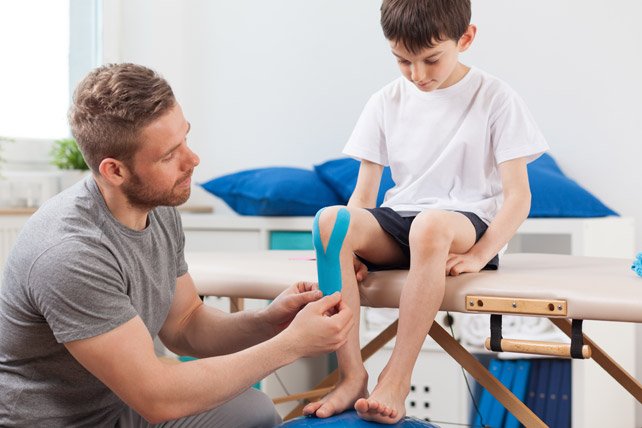
A type of physical therapy called paediatric physiotherapy is intended mainly to benefit children and teenagers.Paediatric physiotherapy aims to improve the child’s ability to move, reduce pain, help them recover from an injury, and prevent future problems. This article will go into greater detail about paediatric physiotherapy.
What is Paediatric Physiotherapy?
Paediatric physiotherapy aims to reduce pain or disability caused by an injury or illness so you can return to normal activities without pain or discomfort. The treatment should address what is causing your symptoms and focus on keeping you physically strong so that you can avoid future problems and prevent future injuries or illnesses from occurring again.
Paediatric physiotherapists often work with other health professionals, such as occupational therapists, speech-language pathologists, and orthopaedic surgeons, to care for children with special needs such as cerebral palsy or Down syndrome. They also work with children of all ages but most commonly treat infants and preschoolers. Child physiotherapy provides care for children who have chronic illnesses such as asthma or diabetes or those who are living with disabilities caused by congenital conditions or accidents by giving them interventions that will be beneficial in their situation.
When is Paediatric Physiotherapy Used?
The main reason for using paediatric physiotherapy is to help children develop normally through childhood and into adulthood. Children unable to use their bodies properly may have trouble walking or moving around because of muscle weakness or poor coordination. Some children may have difficulty communicating due to muscle weakness in their faces or mouth. These problems can affect everyday life as well as academic performance at school.
Paediatric physiotherapists can assess these problems by giving strength tests and asking parents or teachers to push down on different parts of the body while they try to correct them. Paediatric physiotherapy can help treat conditions affecting the bones, muscles, joints, and the nervous system. Additionally, they provide treatment for conditions like Down syndrome, spina bifida, muscular dystrophy, and cerebral palsy. Paediatric physiotherapists often work closely with other medical professionals, such as paediatricians, neurologists, and occupational therapists.
Who Will Benefit From Paediatric Physiotherapy?
Paediatric physiotherapy is a specialised area that helps children that undergo certain diseases with the assistance of therapists trained to meet the needs of children with a wide range of conditions. Here are some situations that can benefit from child physiotherapy.
- Developmental Dysplasia of the Hip (DDH)
When a baby’s hip socket is not correctly formed, it doesn’t fit into place properly. It may cause pain in the leg or knee, which may be worse when walking. The baby may also limp or have trouble crawling because they can’t put weight on one side. Paediatric physiotherapy can help minimise pain by guiding the patient through rehabilitation or interventions.
- Cerebral Palsy
This condition affects muscle tone (how strong your muscles are), balance, and movement due to damage to the brain before or after birth. It can affect all parts of your body but most commonly involves your arms and legs differently, so you may find it harder to do everyday tasks like dressing yourself or walking upstairs. In this case, child physiotherapy is essential to improving and teaching the patient life skills that are beneficial in multiple ways.
- Muscular Dystrophy
A hereditary condition that results in skeletal muscle degeneration and gradual weakening throughout the body is known as muscular dystrophy. About 40 types of muscular dystrophy are caused by defects in genes responsible for producing proteins needed for muscle function. Child physiotherapy is given to help them manage simple tasks that are helpful in daily living.
- Surgery Rehabilitation
Children of all ages can benefit from paediatric physiotherapy. Children who have been injured, are recovering from surgery, or have long-term medical conditions. Children who have suffered fractures or other injuries may also benefit from the expertise of a skilled paediatric physiotherapist. They will work with you to determine the best way to treat your child’s damage so that it heals quickly and leaves your child feeling as good as new again!
- Spina Bafida
Children with spina bifida may benefit from child physiotherapy provided by a paediatric physiotherapist. These children can often use wheelchairs if they have reduced leg mobility. A skilled physiotherapist will work to improve their leg strength so they can walk again.
Summary
In paediatric physiotherapy, physiotherapists are trained professionals who help patients regain their physical health. They can be found in hospitals, rehabilitation centres, and private clinics. Some focus on specific groups of people, like athletes or older adults; others focus on particular areas of the body, such as the spine or neck. The role of a paediatric physiotherapist is to assess and treat musculoskeletal problems such as scoliosis, clubfoot, and hip dysplasia that affect children. They will also manage cerebral palsy, developmental delays, learning disabilities, and other neurological conditions like cerebral palsy.